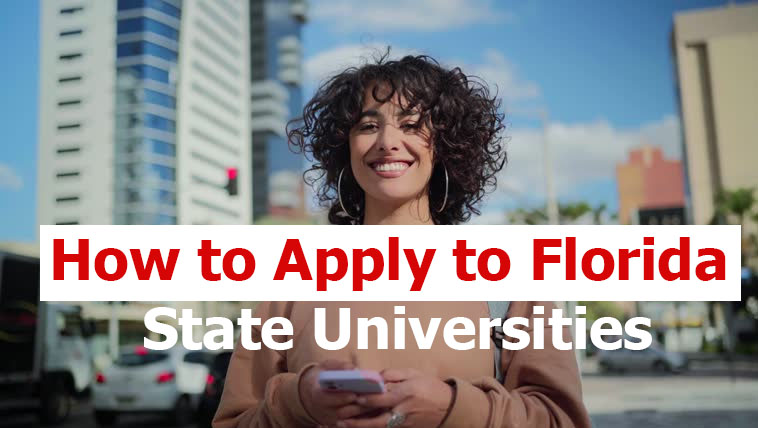Florida’s 12 public universities (State University System of Florida), governed by the State University System, each handles its own admissions process—typically requiring an electronic application, official transcripts, and test scores . High school students meeting minimum GPA and course requirements may still need to align with individual campus criteria due to competition for space.

How to Apply to Florida State Universities (Quick Steps):
Check eligibility: minimum GPA, required coursework, Talented Twenty program for top-ranked students.
Choose and submit your application using either Common App or university-specific portal (FSU, USF, UF).
Gather and upload documents: self-report transcripts (STARS), test scores, residency forms, essays.
Meet deadlines: Early Action (Nov/Oct), Regular Decision (Dec–Jan), Rolling (March).
After submission: Monitor portal for decisions, scholarship eligibility, orientation invites. File for fee waivers or financial aid (FFAA).
Apply Now for State University of Florida
How to Apply to Florida State Universities
Applying to Florida state universities can feel overwhelming, but breaking it down into steps makes the process more manageable. Florida is home to highly ranked institutions like the University of Florida (UF), Florida State University (FSU), and the University of South Florida (USF).
Each school has its own admissions platform, requirements, and deadlines, but the overall application journey follows a similar structure. This guide will walk you through each step in detail, ensuring you understand what’s required to maximize your chances of admission.
1. Research and Choose Your Universities
Before you start any application, you need to research the universities within Florida’s State University System. Each school has unique programs, student culture, and admission competitiveness. For example, the University of Florida (UF) and Florida State University (FSU) are more selective, while others like Florida Gulf Coast University (FGCU) or the University of West Florida (UWF) may offer more flexible admission standards. This means knowing where you fit academically and socially is key.
When researching, pay attention to academic majors, extracurricular opportunities, campus life, and geographic location. For STEM, UF and UCF stand out, while FSU excels in liberal arts and business, and Florida A&M University (FAMU) has strong health science programs. Aligning your career goals with what the university offers ensures your education works for you.
Another factor to consider is tuition and costs. In-state tuition for Florida residents is significantly lower compared to out-of-state rates. If you qualify for residency, you’ll pay far less. Additionally, some universities offer merit-based scholarships that reduce expenses even further. Knowing these details early helps with financial planning.
It’s also smart to check student-to-faculty ratios and graduation rates. These give you an idea of how personalized your education might be. For example, larger schools like UCF have vast resources but also larger class sizes, while smaller universities like New College of Florida provide more individualized attention.
Lastly, make a shortlist of at least three to five universities. Having multiple options ensures you’re not putting all your hopes into one application. It also provides backup plans if you don’t get into your top choice.
2. Meet General Eligibility Requirements
The first step in applying to a Florida state university is ensuring you meet the baseline eligibility criteria set by the Florida Board of Governors. To qualify, applicants must graduate with a standard high school diploma and maintain at least a 2.5 GPA in 18 required academic courses. These courses span English, math, science, social studies, foreign language, and electives. Florida emphasizes academic rigor, so excelling in these areas signals readiness for college-level work.
In addition to coursework and GPA, applicants are required to take either the SAT or ACT. While some universities may adopt test-optional policies in the future, most still require students to submit scores. The Florida Department of Education offers detailed guidance through FloridaShines, a resource that helps students and families track course completion and prepare for college admission.
Another important program is the Talented Twenty initiative. Students who rank in the top 20% of their graduating class and complete the required 18 core courses automatically qualify for admission to at least one Florida state university. While this does not guarantee a spot at your first-choice institution, it ensures an opportunity within the system.
Even if you meet these minimum standards, remember that top schools like UF and FSU are highly competitive. Their average admitted student GPA and test scores often exceed the state minimums. That means meeting baseline eligibility opens the door, but you should aim to exceed expectations for a stronger chance of admission.
By understanding these foundational requirements, you establish a solid starting point. From here, your application strategy should focus on choosing the right platform, meeting deadlines, and submitting competitive materials that highlight your strengths.
3. Choose & Submit the Right Application
Once you’ve confirmed eligibility, the next step is selecting the right application platform for your target school. Many Florida state universities accept both the Common App and their own institutional applications, but the choice may impact the materials and deadlines you’ll need to follow. Carefully reviewing each school’s system is critical.
For example, Florida State University (FSU) allows students to apply via the Common App or FSU’s own application. When applying, you’ll need to complete sections covering academic history, self-reported test scores, transcripts via STARS, and essays. If you’re interested in the Honors Program, indicate this early so you receive supplemental prompts. Deadlines are strict: Early Action by October 15, Regular Decision by December 1, and Rolling Admissions through March 1.
At the University of South Florida (USF), applicants can use either USF’s application portal or the Common App. The process includes a $30 application fee, though fee waivers are available. USF requires test scores (SAT, ACT, or CLT) to be sent directly from the testing agencies, and it also recognizes superscoring across multiple test attempts.
The University of Florida (UF) also offers multiple application pathways. Students can apply through the Common App or UF’s system. The deadlines are Early Action on November 1 and Regular Decision on January 15. Applications are completed through the Gator Portal, where students upload test scores, transcripts, and supplemental essays.
Choosing the right application platform isn’t just about convenience—it’s also about strategy. Some platforms provide essay flexibility or streamlined document uploads. Take the time to review each option and select the one that best highlights your strengths.
4. Gather and Upload Supporting Documents
After you’ve submitted your initial application, the next step is ensuring all supporting documents reach the university on time. This includes official transcripts from your high school and official test scores from SAT, ACT, or CLT providers. For USF, direct submission from testing agencies is mandatory, while UF and FSU use a mix of self-reported and verified documents.
Every Florida university provides a dedicated admissions portal—such as FSU’s Admissions Portal, UF’s Gator Portal, and USF’s applicant hub. These portals are where you’ll upload documents, check for missing items, and track the progress of your application. They also serve as communication channels where schools post updates about admission status, supplemental prompts, and residency declarations.
5. Check Portals Regularly
One common mistake applicants make is submitting the application and forgetting to check the portal. Missing documents or incomplete forms can delay your application or disqualify you from consideration. Make it a habit to log in regularly, especially in the weeks leading up to deadlines.
In addition to transcripts and test scores, some universities may request residency declarations or financial documentation. For instance, claiming Florida residency can significantly reduce tuition, so submitting proof of residency on time is vital.
By staying proactive and monitoring your portal frequently, you can ensure your application remains complete and competitive. This step is all about diligence and following through after the initial submission.
6. Meet Deadlines & Placement Options
Florida’s state universities operate with strict timelines, and missing deadlines can severely limit your options. Each university sets its own Early Action, Regular Decision, and Rolling deadlines, and these vary by institution. Planning ahead is key to maximizing your chances.
At FSU, Early Action is only available to Florida residents, with an October 15 deadline and materials due by October 22. Decisions are typically released in December. The Regular Decision deadline is December 1, while Rolling Admissions extends to March 1. Applicants who want early results often aim for the Early Action cycle.
At UF, the Early Action deadline is November 1, and Regular Decision is January 15. Admissions decisions are typically released between January and March. Because UF is one of the most competitive public universities in the nation, applying early often strengthens your case by demonstrating interest and preparedness.
For USF, deadlines vary but generally align with Fall admissions cycles. A key requirement is completing the STARS form within seven days, which is critical for securing an admissions offer.
In addition to standard applications, Florida offers placement alternatives. The 2+2 program, led by the state’s Provost, allows students to begin at a state college and later transfer seamlessly to a university. Similarly, the Talented Twenty program provides automatic admission options for eligible students.
By understanding both the deadlines and alternate pathways, you can create a flexible application plan. This ensures that even if you don’t gain admission through the traditional route, you still have strong options to pursue a Florida university education.
7. After Submission: Next Steps & Final Tips
Submitting your application isn’t the end of the process—it’s the beginning of the waiting game. Once submitted, continue to monitor your admissions portal for status updates, scholarship notifications, and program invitations. Decisions can arrive months later, so patience and attention to detail are important.
Financial aid should also be a priority. Florida offers generous scholarship programs such as Bright Futures, which requires the Florida Financial Aid Application (FFAA) by August 31 after graduation. Missing this deadline can mean losing thousands in potential aid. In addition, universities often award merit-based scholarships automatically based on GPA and test scores.
For students facing financial hardship, fee waivers are available. Schools like USF and FSU recognize waivers from testing agencies (SAT, ACT) and offer institutional waivers upon request. Taking advantage of these can significantly lower the cost of applying.
Students interested in specialized programs—such as UF’s Innovation Academy or FSU’s Honors Program—should reach out early. These programs often have unique requirements, supplemental essays, or earlier deadlines that require careful planning.
The final tip is to stay engaged. Attend virtual tours, connect with admissions officers, and keep an eye on orientation schedules. Demonstrating interest and initiative not only helps you stay prepared but also leaves a positive impression on admissions staff.
Final Thought
Applying to Florida state universities involves multiple steps, from meeting eligibility requirements to tracking application portals and financial aid deadlines. Each stage requires attention to detail, especially when targeting competitive schools like UF, FSU, and USF. By following this structured approach—eligibility, application choice, supporting documents, deadlines, and next steps—you’ll be well-positioned to navigate the process successfully.
With preparation and persistence, you can maximize your chances of earning admission and starting your college journey at one of Florida’s top public universities.
Also Check:
Best Fully Funded PhD Programs to Apply Now
NVIDIA Graduate Fellowship 2025: Deadline September 15, 2025
Oxford Pershing Square Graduate Scholarships 2026 in UK (Fully Funded)
